Incredible historic photos show what America looked like in the 19th century
America rises
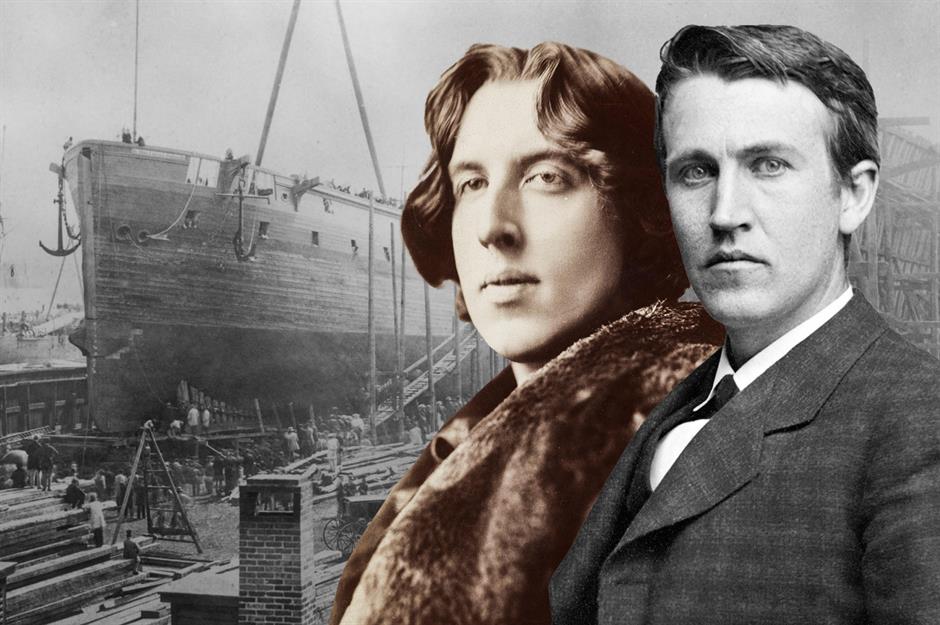
As the 19th century dawned, the United States was a fledgling nation. By its close, it had emerged as the dominant power in the Western Hemisphere. This transformative century witnessed the devastation of civil war, the rise of the railway and the birth of modern marvels like skyscrapers, automobiles and telecommunications. Thanks to the revolutionary technology of photography, many of these pivotal moments were captured in vivid detail.
Click through this gallery to discover the people and events that shaped America during the 19th century. To enjoy these images FULL SCREEN, click the icon in the top right...
1843: President John Quincy Adams
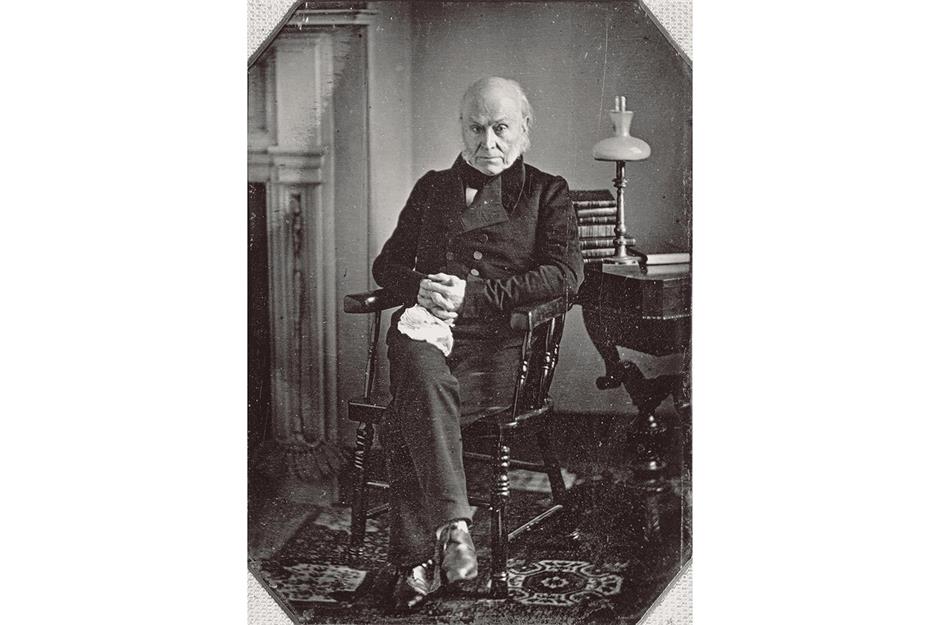
The oldest surviving photograph of a US president, this unique daguerreotype of a stern-faced John Quincy Adams was taken at the studio of artist Philip Haas and dates from March 1843, just four years after Louis Daguerre’s pioneering invention was revealed to the world. Adams was America’s sixth president and the last to have direct ties to the Founding Fathers. He sat for more than 60 portraits during his lifetime, but did not always like the outcome, declaring the results of a sitting later that same year "all hideous".
1846: The White House
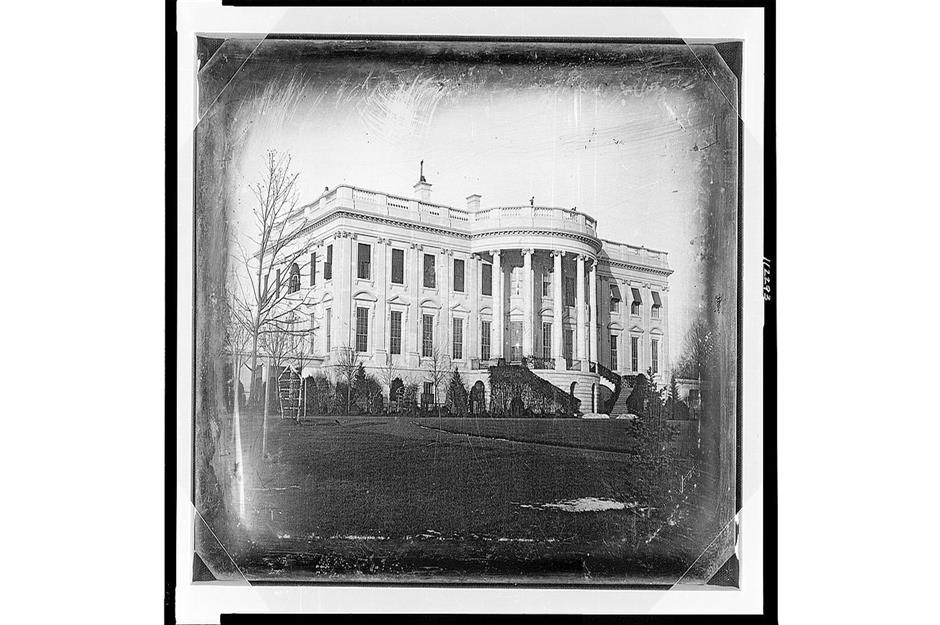
Government buildings in Washington DC were some of the first structures to be documented in the nation’s capital by the new medium of photography. This early view of the White House, then known as 'the Executive Mansion' was taken during the administration of James K Polk by John Plumbe Jr, the city’s first professional photographer. One of the most famous buildings in the world, the White House has been the official residence of every US president since John Adams in 1800.
1848: Dolley Madison and niece
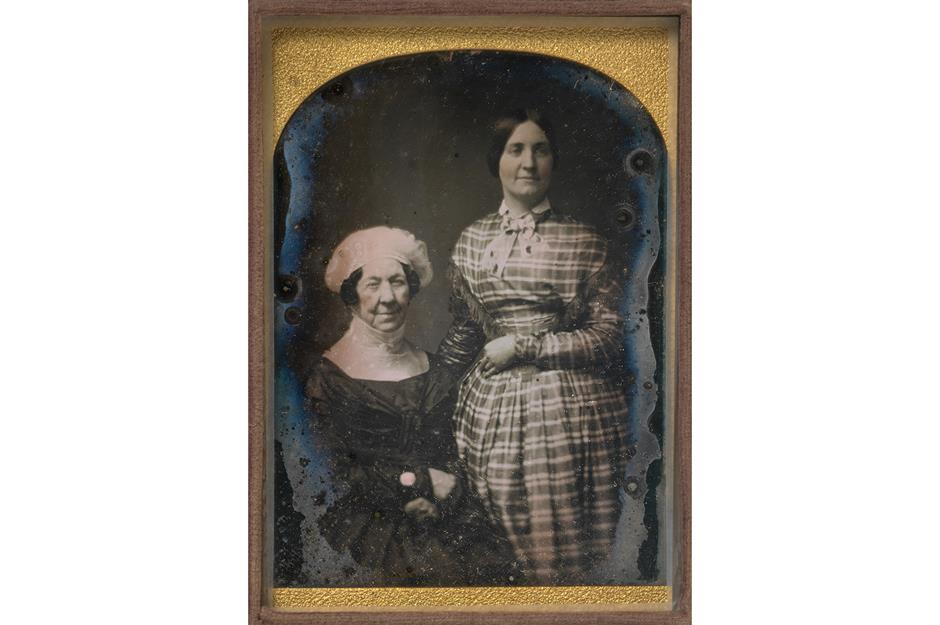
The wife of America's fourth president, James Madison, Dolley Madison was one of the nation’s most significant first ladies. Celebrated for her social skills and taste, she was a key figure in establishing early Washington society, helped decorate and furnish the White House, and wielded considerable political influence.
Her popularity continued long after her husband’s death, and when she returned to Washington in 1837 she became something of a celebrity. This daguerreotype is one of several taken by Mathew Brady, capturing the venerable first lady, together with her niece, a year before her death.
1848: Steamboat on the Cincinnati waterfront
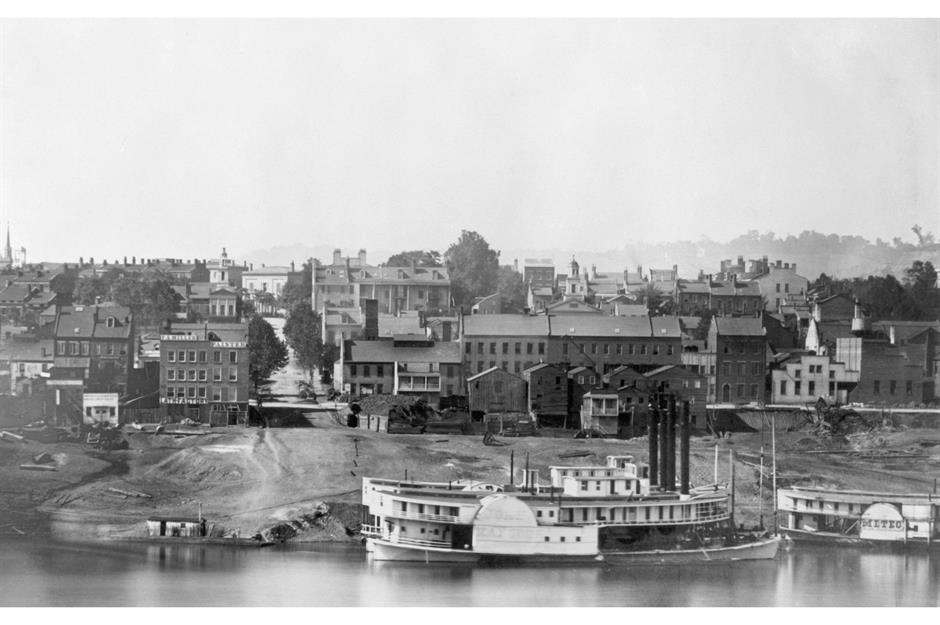
Before the completion of the Transcontinental Railroad in 1869, steamboats were the principal means of moving freight across America and played a major role in the nation’s economy, agriculture and commerce. Cincinnati, for example, grew rapidly after the introduction of steamboats on the Ohio River in 1811, with pork and hay as its principal exports.
Some larger steamboats were quite luxurious, but most had short lifespans. Often poorly constructed, they were prone to sinking and to exploding boilers, which caused around 4,000 deaths between 1810 and 1850.
1852: California Gold Rush miners
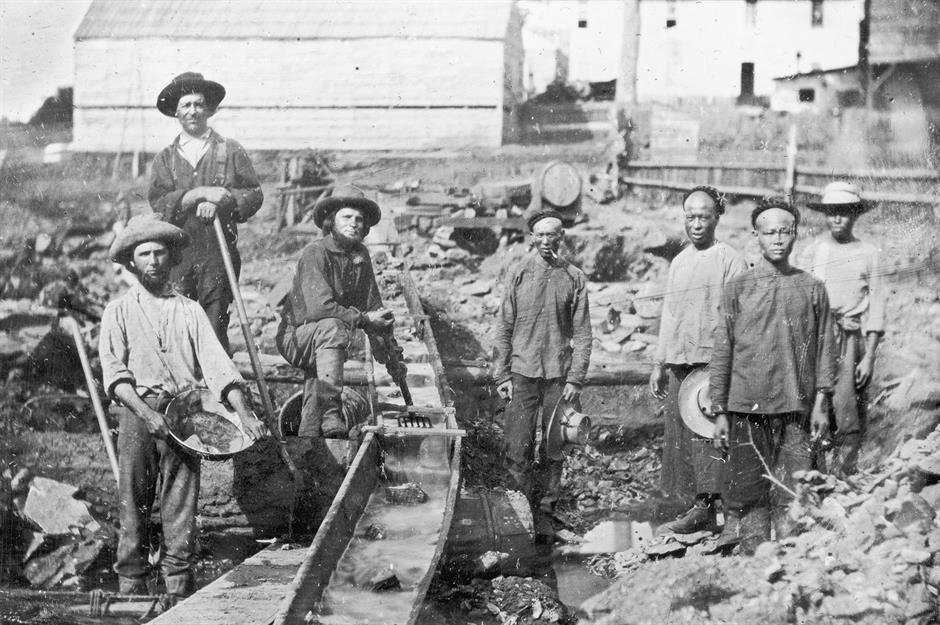
When James W Marshall struck gold at Sutter’s Mill in Coloma, California, in January 1848, few could have predicted the results. Over the next few years, some 300,000 prospectors descended on the region from every corner of the globe. Enormous amounts of gold were extracted, but few prospectors made their fortunes, and many suffered from the arduous work and harsh living conditions.
The consequences for California's Indigenous societies were even worse, with many pushed off their land or falling victim to disease and starvation. The rush peaked in 1852 and was over by the decade’s end.
c.1860: The Washington Monument
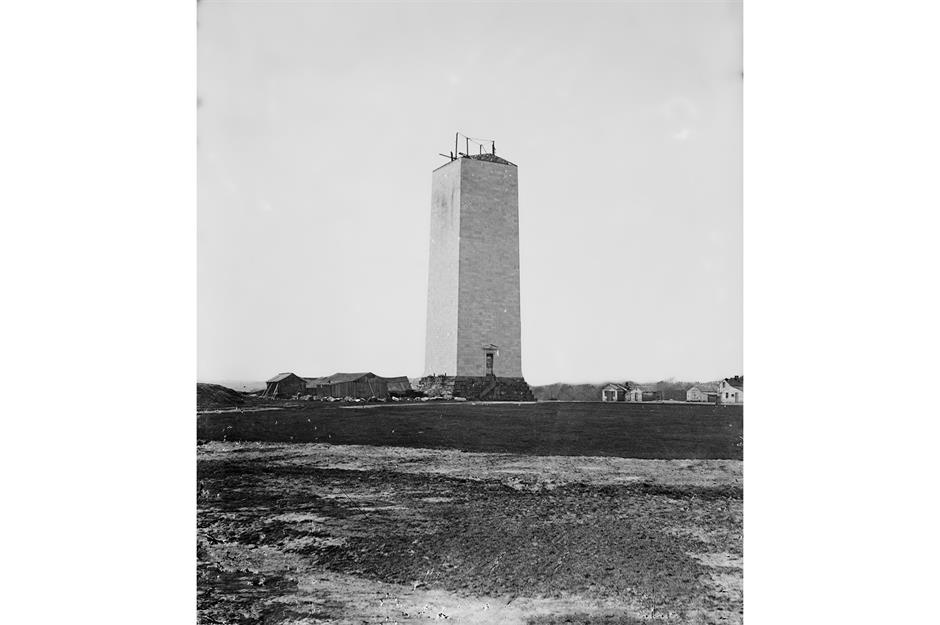
Construction of the Washington Monument first began in 1848 and continued until 1856 when first lack of money and then the Civil War halted further work. The unfinished monument was around 150 feet (46m) tall at that time and, according to Mark Twain, resembled a "hollow, oversized chimney".
During the war, land around the monument was used to graze cattle and the monument itself was used as a slaughterhouse. Visitors were allowed to climb to the top, as even at a third of its eventual height, it was the tallest building in America and something of a tourist attraction.
1861: Confederate flag flying over Fort Sumter
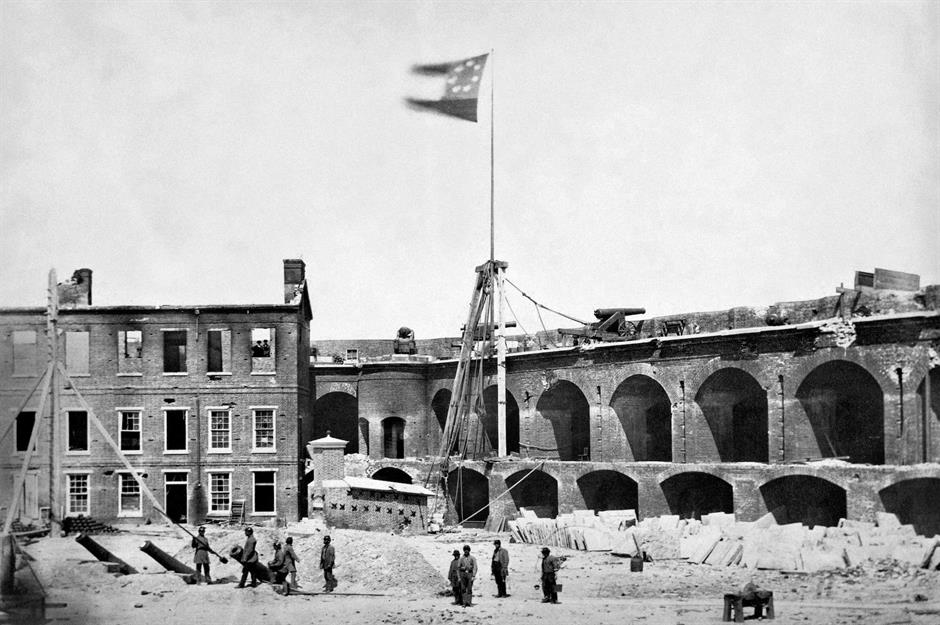
The attack on Fort Sumter in Charleston Harbor, South Carolina on 12 April 1861 marked the beginning of the American Civil War, a conflict that would last four years, claim more than 620,000 lives and set almost four million enslaved people free. The South Carolina Militia quickly captured the fort from the Union garrison stationed there, after which Virginia, Arkansas, North Carolina and Tennessee also joined the Confederacy, bringing the number of rebel states to 11. The flag seen here, however, is the original 'Stars and Bars' with only seven stars.
Love this? Follow our Facebook page for more travel inspiration
c.1862: Campbell General Hospital, Washington DC
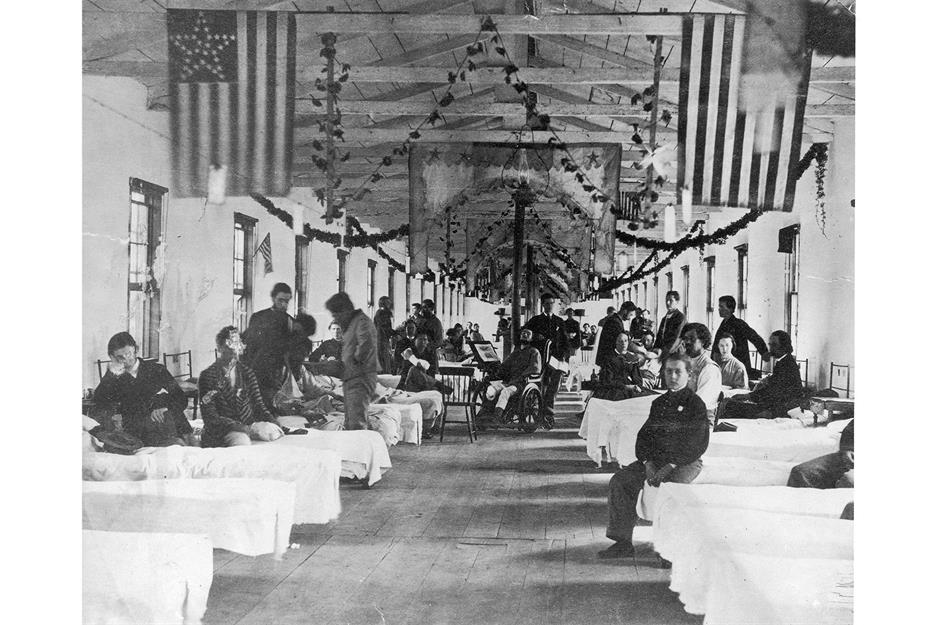
The enormous number of casualties in the Civil War meant that medical facilities for injured soldiers were desperately needed. Operating from 1862 to 1865, Campbell General Hospital was one of nearly three dozen military hospitals in Washington DC alone.
As Harriet Beecher Stowe noted, the capital "was one great hospital of wounded soldiers: the churches, the public buildings all filled with the maimed, the sick and suffering". The unusual Union flag seen here, with only 34 stars, was one of four different ones used during the course of the conflict.
1862: Former enslaved people, Virginia
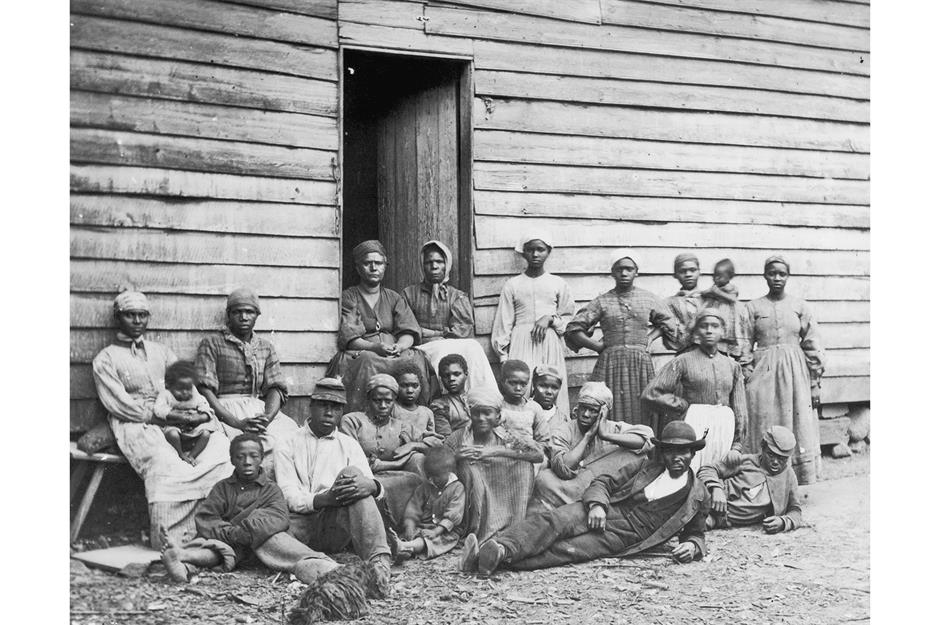
During the Civil War, many enslaved people fled their plantations and sought refuge behind Union lines. This image was taken following the Peninsular Campaign of 1862, when Union forces gained control of areas in southeastern Virginia.
Although federal law initially required the return of escaped enslaved people to their owners, Union forces often treated them as 'contraband of war', effectively granting them their freedom. Many of these individuals were sent to Washington DC to work as labourers on fortifications, often receiving minimal or no pay for their efforts.
1863: William H Webb Shipyard
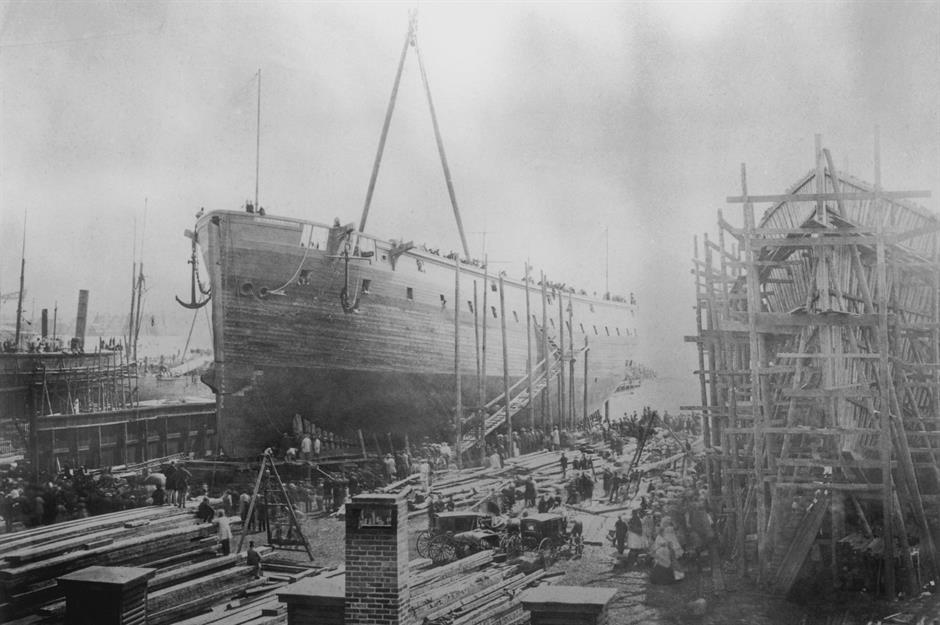
New York in the 1860s was the centre of American shipbuilding. The Manhattan and Brooklyn banks of the East River were lined with shipyards, and none was bigger than that of William Henry Webb, America’s 'first naval architect'. Taking over his father’s company in 1840, he quickly became the country’s most successful shipbuilder, constructing 135 vessels over the next 29 years, including the one pictured here.
1865: Lincoln’s second inaugural address
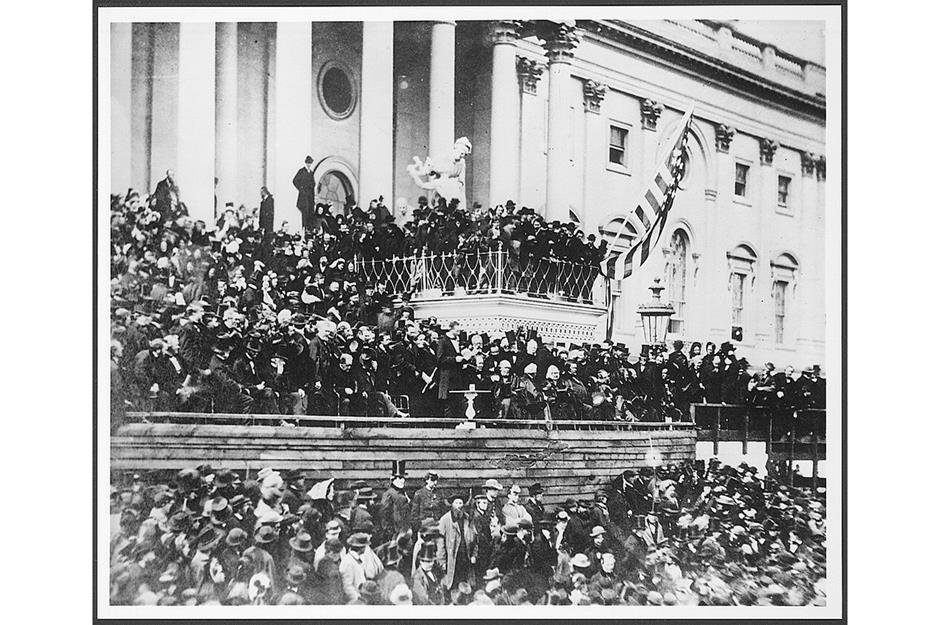
As the Civil War dragged on, it seemed uncertain whether Abraham Lincoln would win a second term in office. However, major Union victories in late 1864 turned the tide in his favour and he was re-elected with a significant margin of votes. In his second inaugural address on 4 March 1865 he laid out his vision of post-war America, calling for a "just and lasting peace", in what would become one of the most famous speeches in the nation’s political history – its words now enshrined on the Lincoln Memorial in Washington DC.
1865: Grand review of the armies
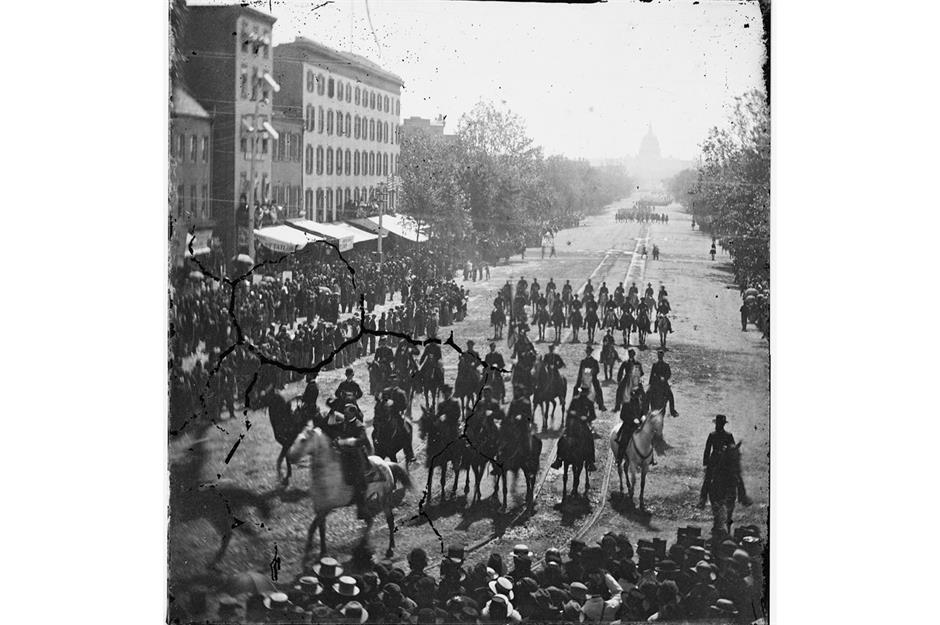
On the 23 and 24 May 1865, the victorious armies of the United States assembled in Washington DC for a celebratory parade to mark the end of four years of bloody conflict during the Civil War. Over the course of two days, 145,000 troops marched from the capitol building to the White House, watched by the largest civilian crowds ever assembled in the city. They were reviewed by General Ulysses S Grant and president Andrew Johnson, inaugurated only a month earlier following the tragic assassination of Abraham Lincoln.
1865: Pioneer Run Creek oil field
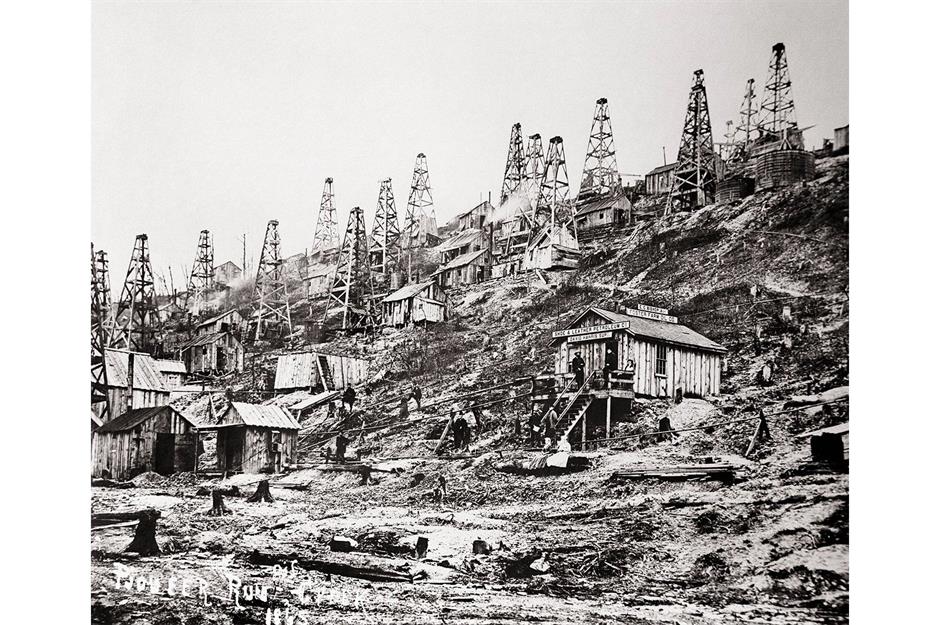
The American oil industry began in August 1859 when a drilling rig was used to extract oil for the very first time near Titusville, Pennsylvania. Within a few years this small settlement of 250 people had grown into a city of around 10,000 and dozens of additional drilling rigs had sprung up on the site. America would go on to become the world’s biggest oil producing nation for much of the 19th and 20th centuries, a title it retains to this day.
1867: Main Street, Salt Lake City
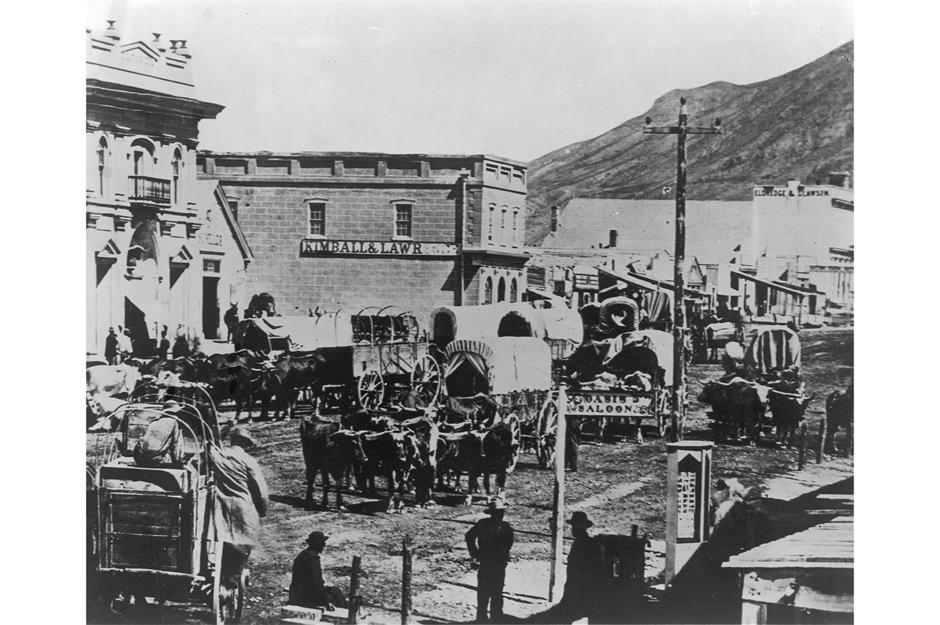
1867: Covered wagon, Carson Desert, Nevada
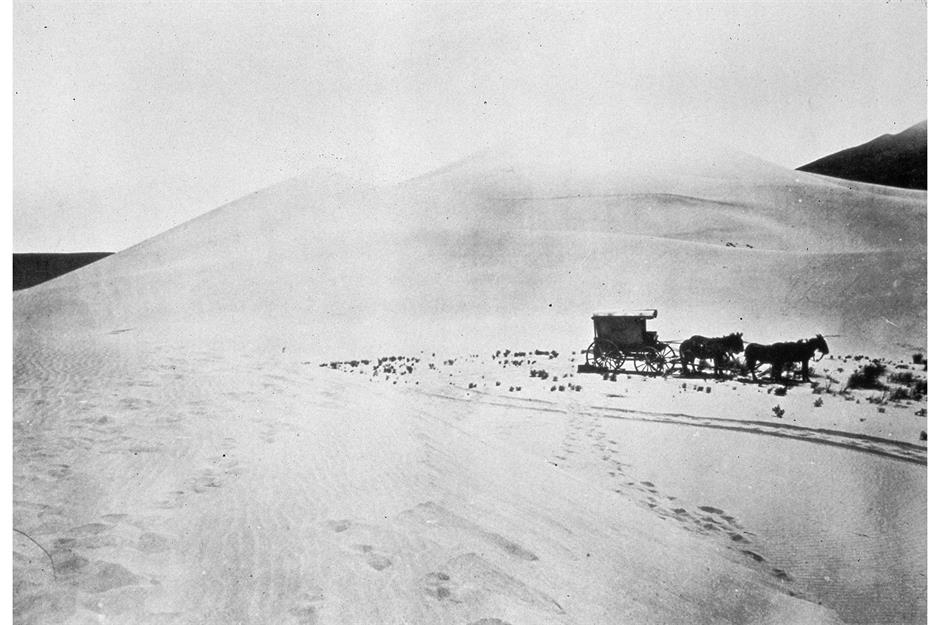
The covered wagon seen here in the desolate dunes of the Carson Desert in Nevada is the mobile darkroom belonging to photographer Timothy H O'Sullivan. O'Sullivan had got his big break working for the famed Civil War photographer Mathew Brady.
After the war, he joined the geologist Clarence King’s exploration of the territory between the Rocky Mountains and the Sierra Nevada Mountains. His work from this period can be seen as both scientific documentation and an evocative portrayal of the mesmerising qualities of the western landscape.
1869: Completion of the Transcontinental Railroad
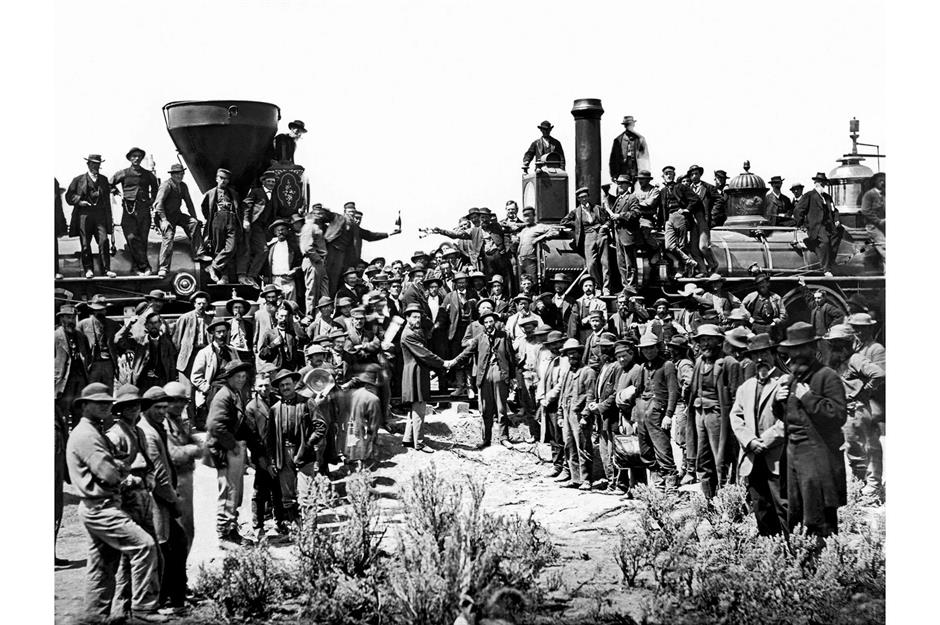
The completion of the Transcontinental Railroad was one of the most significant moments in American history. On 10 May 1869, a ceremonial gold spike was driven into its final rail at Promontory Summit, Utah, linking the Central Pacific and Union Pacific Railroads to create a continuous 1,776 mile (2,858km) line from coast to coast.
The impact was enormous, opening up the west to settlers and allowing long distance freight transport on an industrial scale for the first time. But the railroad also devastated western forests and heightened racial tensions.
c.1870: Virginia City, Nevada
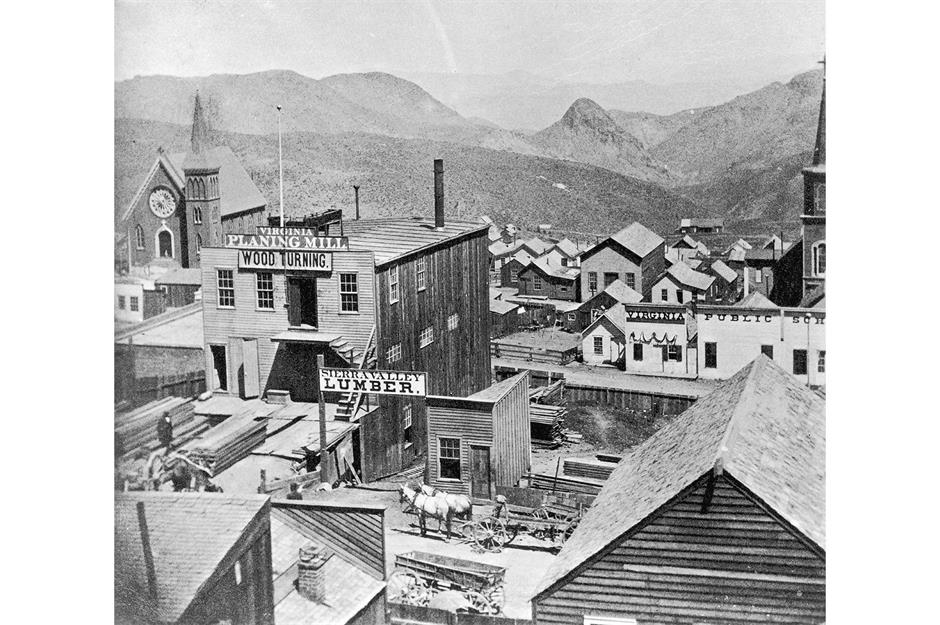
Boomtowns are a vital part of American history, and few embody the phenomenon better than Virginia City. In 1859, the discovery of the Comstock Lode, a rich deposit of silver ore, quickly turned it into a bustling metropolis of 25,000 people, its streets lined with grand mansions, opera houses and schools.
But when the silver began to run out in the late 1870s people abandoned the city, and today it has a population of less than a thousand. It’s still a major tourist attraction, though, and said to be one of the most haunted towns in America.
Check out these evocative vintage photos of America's cowboys
1871: Pawnee family standing in front of their earth lodge, Nebraska
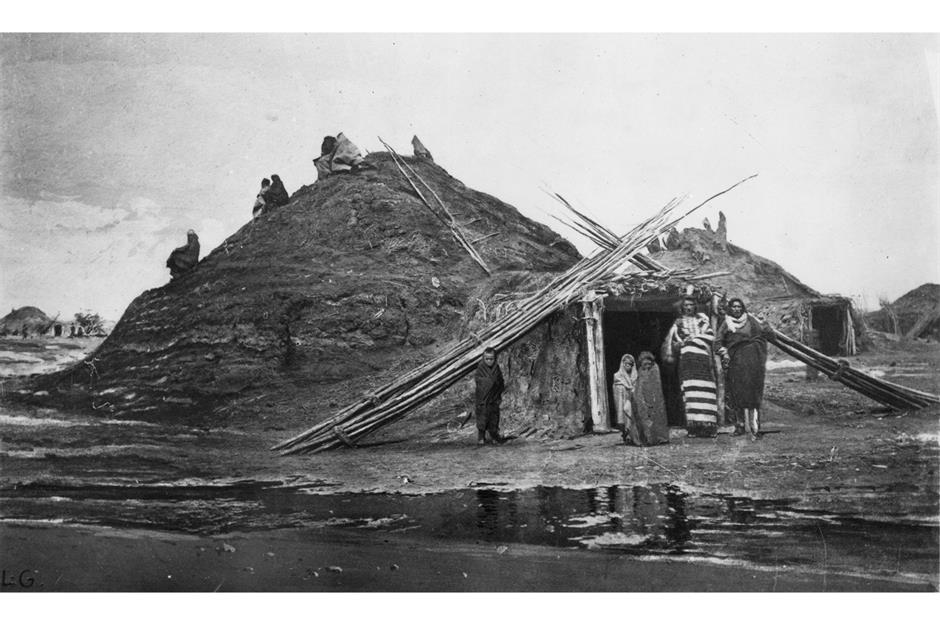
The Indigenous Pawnee people lived close to the Platte River in what is now Nebraska, from before the 16th century until the late-19th century. They lived in large dome-shaped earth-covered lodges, like the one pictured, for most of the year, but used tipis for bison hunts.
The Pawnee ceded most of their land in Nebraska to the US government in treaties in 1833, 1848 and 1857. Only five years after this image was taken, their last Nebraska holdings were given up and they were moved to Oklahoma.
1871: Thomas Edison
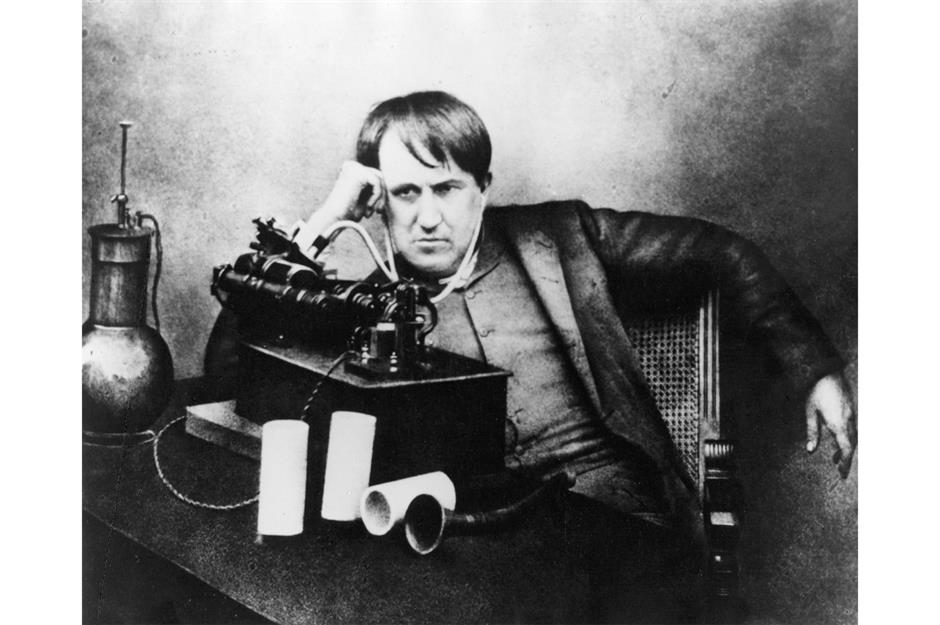
Thomas Alva Edison, one of the most famous inventors of all time, is often hailed as a symbol of American ingenuity and industry. With over 1,000 patents to his name, Edison made significant contributions to the development of the incandescent light bulb, the phonograph and the motion picture camera, while also helping to improve the telephone and telegraph.
In 1876, he established his own laboratory in Menlo Park, New Jersey, often regarded as the world’s first research and development facility. Edison went on to form numerous companies to manufacture and market his inventions. Here, a rather grumpy-looking Edison listens to an early phonograph through a primitive headphone.
1875: Brooklyn Bridge under construction
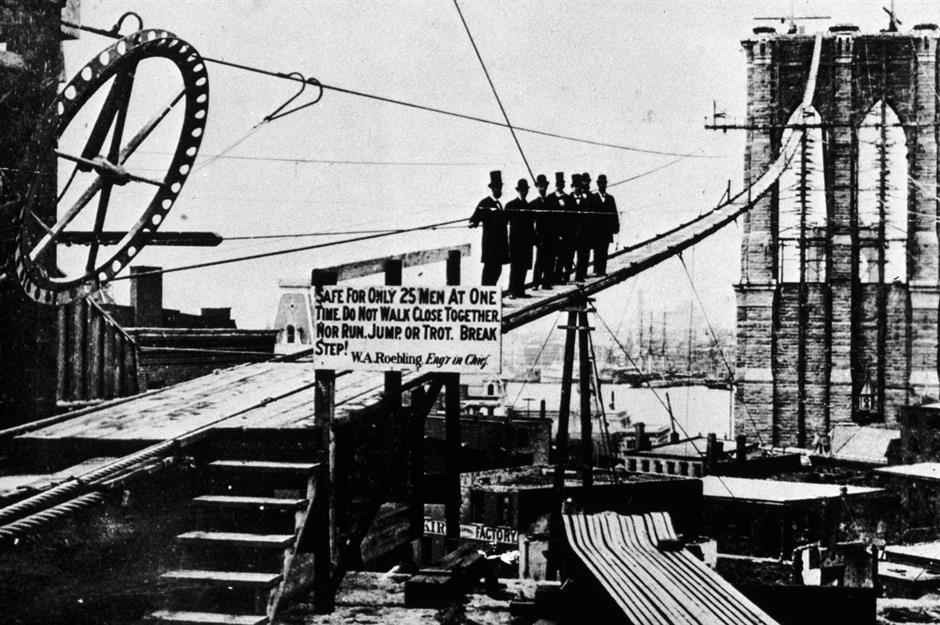
One of the most iconic structures in the US, New York’s Brooklyn Bridge was a major feat of 19th-century engineering. Spanning the East River from Manhattan to Brooklyn, its construction took 14 years (1869-1883) and at the time of completion it was the longest suspension bridge in the world.
Its opening was marked by a major celebration, attended by US president Chester A Arthur. Designated a National Historic Landmark since 1964, it has inspired works by countless poets, painters, photographers and filmmakers.
1876: The Statue of Liberty's arm, Philadelphia World Fair
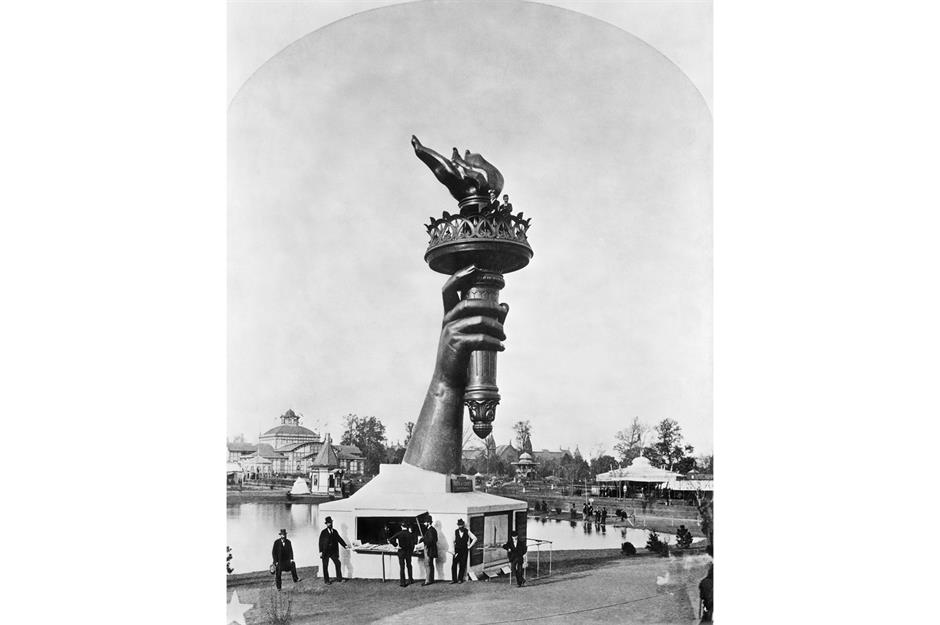
The 1876 Centennial Exhibition, held in Philadelphia to commemorate the 100th anniversary of the signing of the Declaration of Independence, was the first World’s Fair to be held in the United States. On display at the fair was the hand and torch of the Statue of Liberty, the public’s first glimpse of a part of what would become the country’s most iconic monument.
The statue’s designer, Frederic Auguste Bartholdi, constructed the head and hand before the rest of the body, and these were exhibited at international expositions to drum up publicity and raise funds for its completion. The head made its debut at the Paris World’s Fair of 1878.
1880s: Rockefeller ignoring a beggar
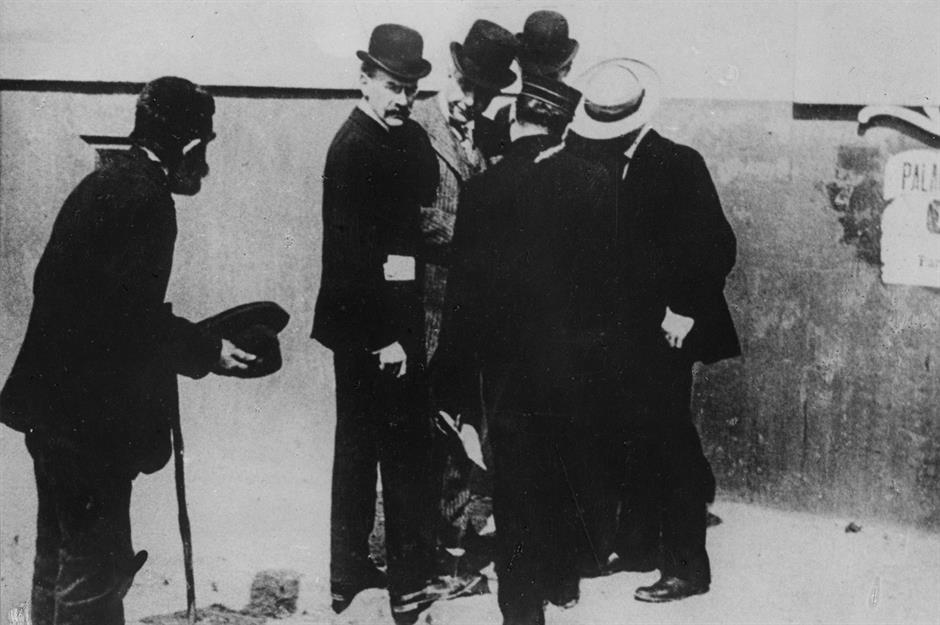
America’s 'Gilded Age', stretching from the late 1870s to the early 1900s, was a period of enormous economic growth and rapid industrialisation. But it was also a time of great poverty and exploitation of the working classes.
That division is perfectly captured in this image of John D Rockefeller, one of the wealthiest Americans of all time, ignoring a beggar who approaches him quite literally cap in hand. Rockefeller’s Standard Oil Company was widely criticised for its ruthless business practices, and this photo was weaponised by his rivals in an attempt to discredit him.
1882: Oscar Wilde’s collectible photographic portrait
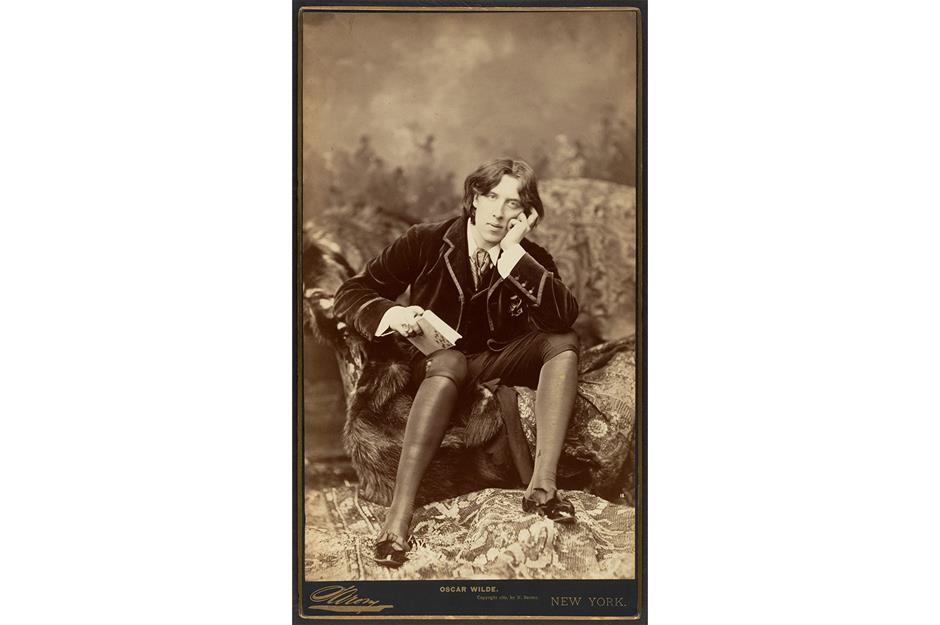
American celebrity culture may seem like a modern phenomenon, but it’s been around for a while. New Yorkers in the 1880s were obsessed with collecting photographic portraits of famous personalities, such as this one of Irish poet and playwright Oscar Wilde dating from his 1882 American tour.
It was taken in the studio of Napoleon Sarony, perhaps the earliest celebrity photographer, which was also visited by Sarah Bernhardt, Mark Twain and others. Such cards were extremely effective. When Wilde returned to London at the end of the year, he had accumulated more US column inches than any other Briton, including Queen Victoria.
1885: The Statue of Liberty’s toes
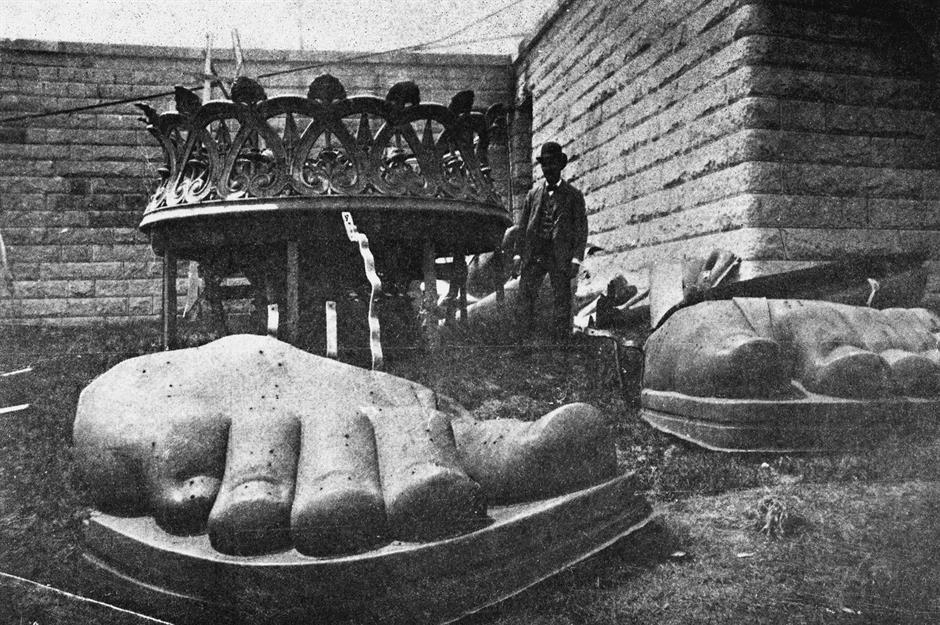
The success of fundraising efforts at the Philadelphia World Fair and other initiatives meant that by the mid-1880s, the construction of the Statue of Liberty could proceed. Completed in France in 1884, the statue was shipped to America in 350 individual pieces, packed into 214 crates, in 1885.
Here, we see the enormous toes of Lady Liberty, with a human figure included for scale. However, the pedestal was not yet finished when the statue arrived, which delayed its assembly until 1886. Once the pedestal was completed, the statue was swiftly put together and unveiled to great fanfare on 28 October 1886.
1886: Geronimo in his camp before the surrender to General Crook
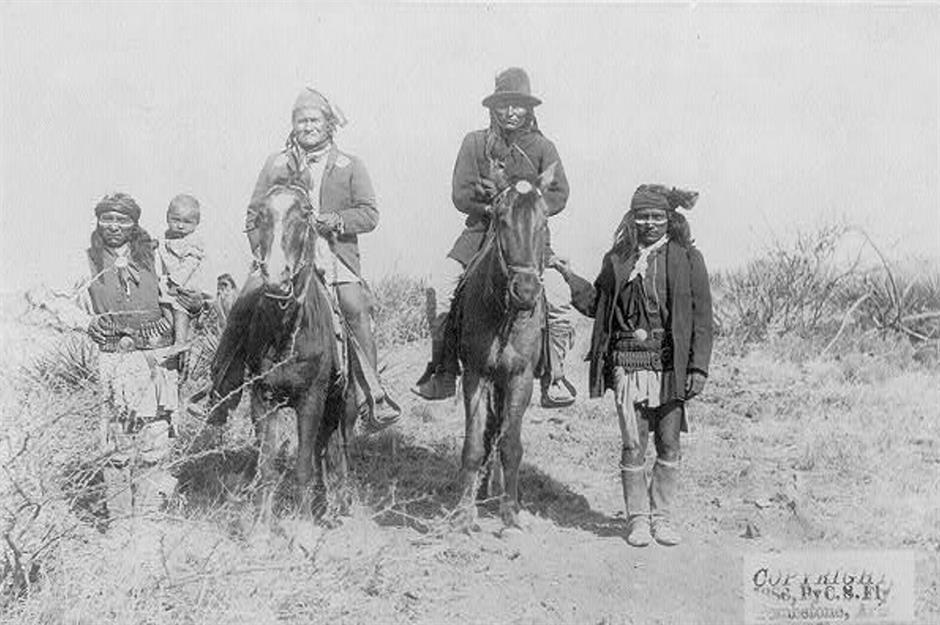
America’s history is sadly intertwined with the ruthless suppression of its native peoples. The Apache leader Geronimo fought for 30 years to defend his tribe’s homeland, battling federal troops and launching raids on white settlements. In March 1886, weary and vastly outnumbered, he was forced to surrender to General Crook.
However, he soon escaped and continued his raids until September, when he surrendered for the final time to General Nelson Miles, marking the end of his resistance. Although he was one of the last Native American warriors to surrender, some resistance continued in other parts of the country.
1887: Homesteaders, Nebraska
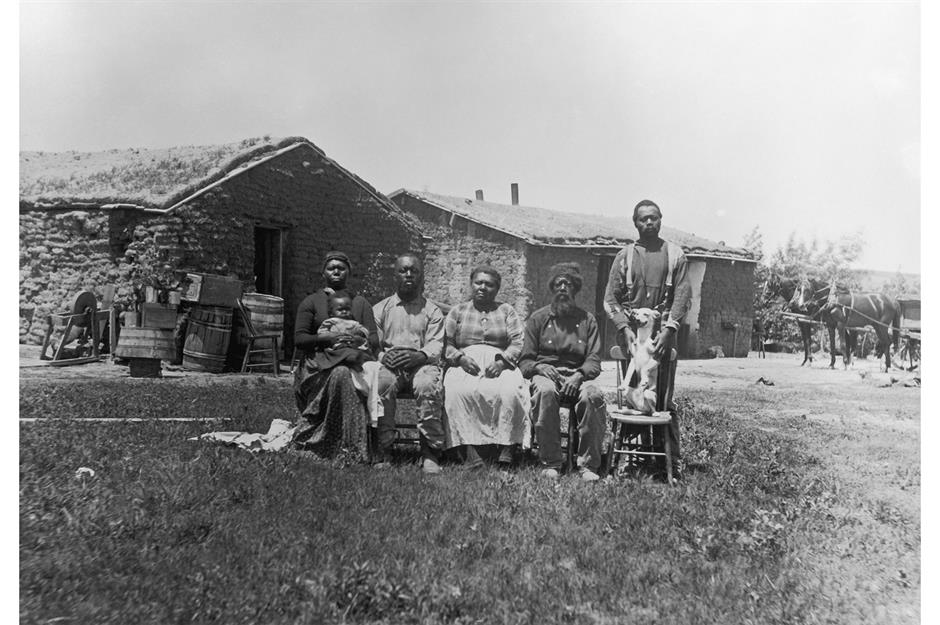
This image shows Jerry Shores, formerly enslaved, and his family outside their homestead near Westerville in County Custer. His property was next to that of his brothers Moses Speese and Henry Webb, and each brother had the surname of their former owner.
African-Americans living in the South after the Civil War ended were no longer enslaved people and were free to make their own lives. Nebraska and other western states may have appealed to them as there were many acres of land for Black farmers to claim, and Nebraska had a reputation as a safe haven for Black people at the time.
1888: International Council of Women
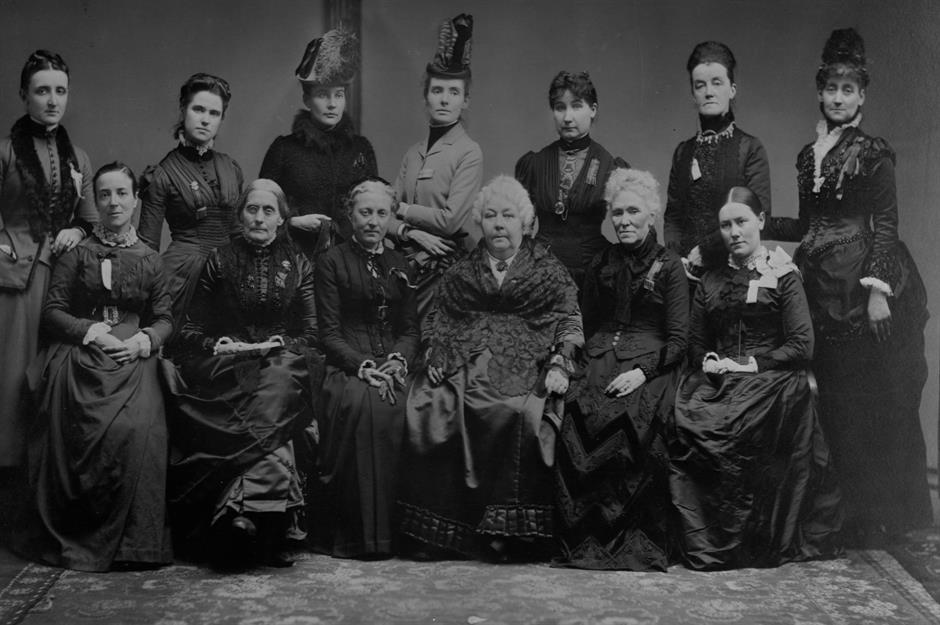
Held in Washington DC in March and April 1888, the first International Council of Women marked a major step in the struggle for women’s rights. Organised by American suffragists Elizabeth Cady Stanton and Susan B Anthony, the Council’s first meeting welcomed 49 delegates from nine countries.
It marked 40 years since the Seneca Falls Convention, the earliest women's rights convention in the United States, had first called for women’s suffrage. While some individual states had granted women the right to vote as early as 1869, it would not become a constitutional right until 1920.
c.1890: Nellie Bly
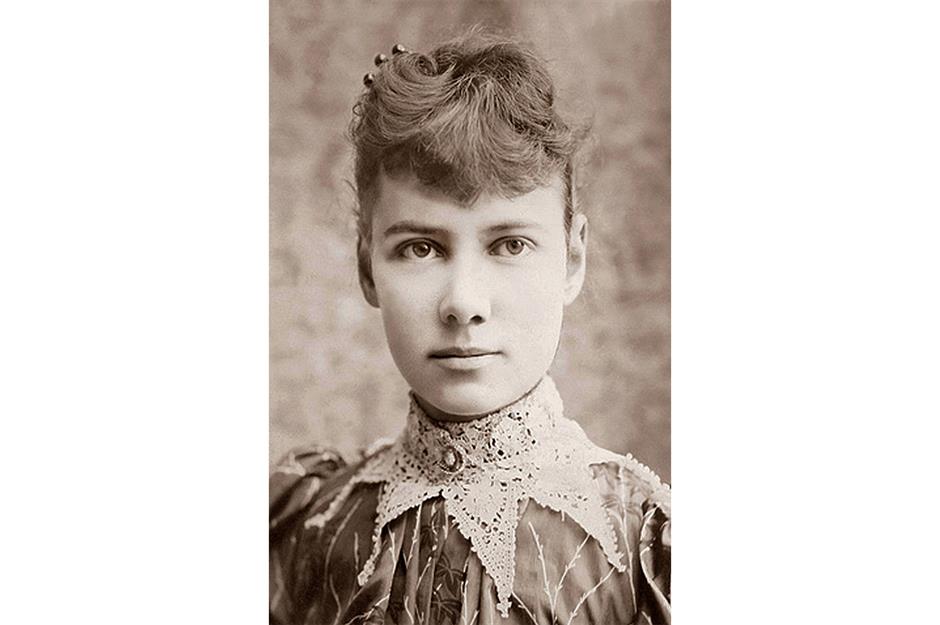
One of the most extraordinary American journalists of all time, Nellie Bly (the pen name of Elizabeth Cochrane) is best known for her attempt to beat the transglobal record of Phileas Fogg, hero of Jules Verne’s Around the World in Eighty Days. She managed it in just 72, and her name became synonymous with the intrepid female reporter.
But that was just the tip of the iceberg. She also wrote pioneering exposés of life in jails, sweatshops and the legislature, and even had herself committed to an asylum to write about the conditions endured by patients.
1890s: Skyscrapers in Chicago
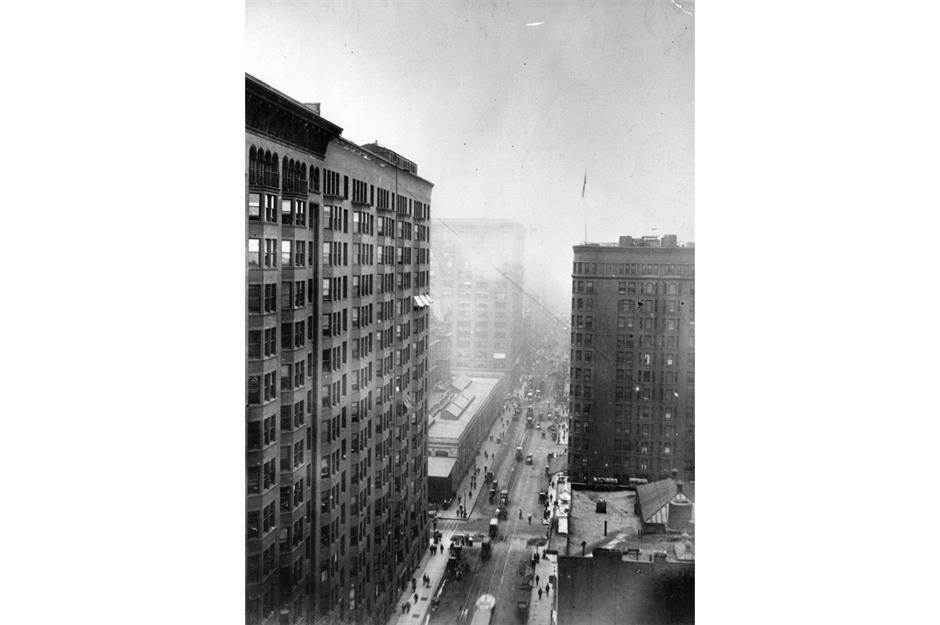
The rapid growth of urban commerce in the late-19th century meant that space in cities was at a premium. The only way to go was up and, facilitated by the emergence of new technologies like steel frames, elevators and electric light, the skyscraper became a reality.
Chicago led the way in the 1880s and 1890s, and several of its earliest skyscrapers are now historic landmarks. The 16-storey Monadnock Building (pictured) is the tallest load-bearing brick building ever constructed and stands as one of the most important examples of the Chicago School of architecture.
c.1892: Five members of The Wild Bunch
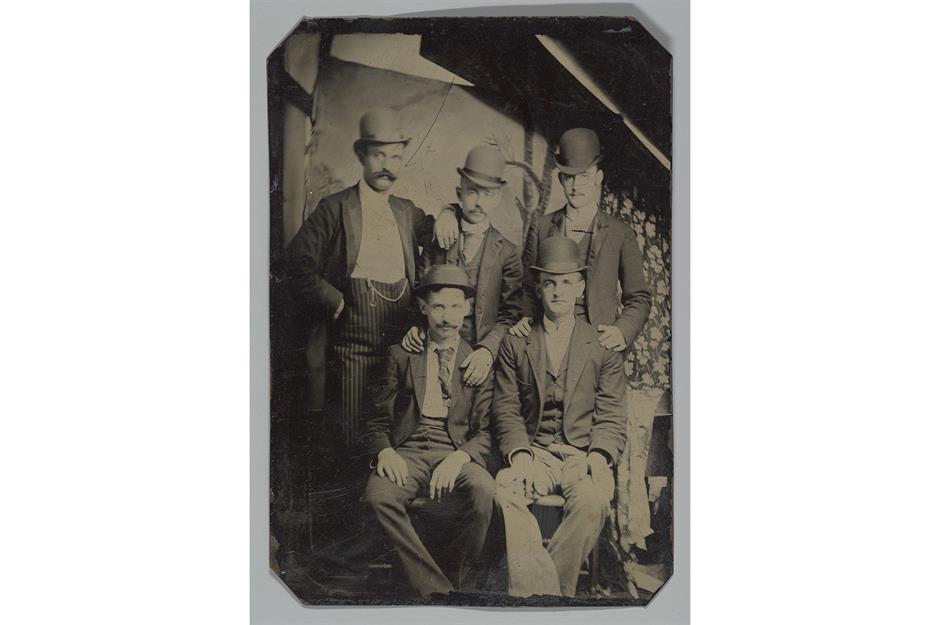
The colourful heroes and villains of America’s 'Wild West' have given the country much of its mythic history, inspiring countless books and films over the past century. And few Western outlaws were more notorious than The Wild Bunch.
Led by Butch Cassidy, their daring train and bank robberies netted the gang tens of thousands of dollars between the 1880s and early 1900s and made them famous from coast to coast. Among the last of the mythic western outlaws, the gang’s end coincided with the final years of the Old West.
1894: Charles Duryea in his third automobile
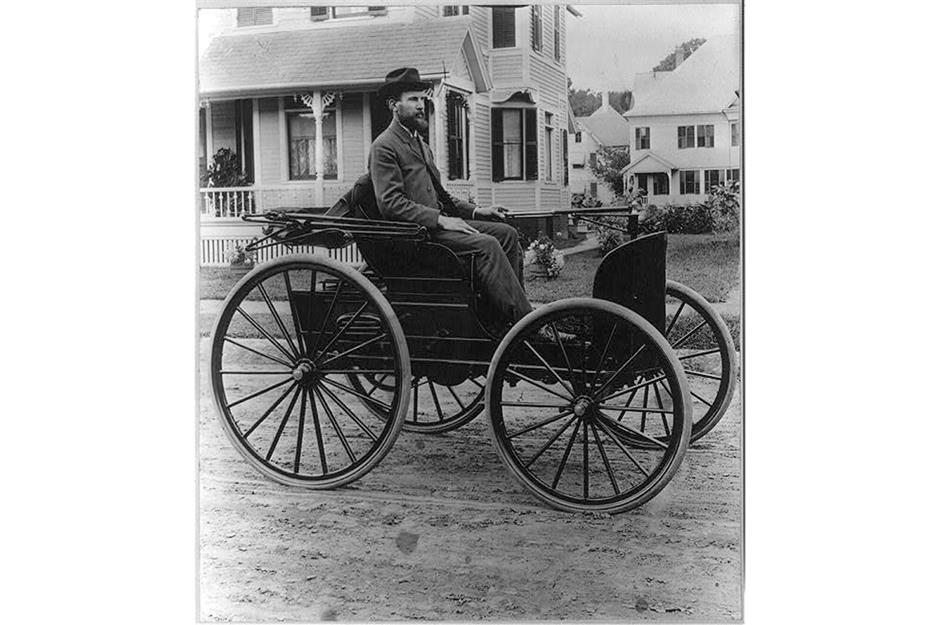
When Charles Duryea and his brother Frank road-tested one of the first successful gasoline-powered automobiles in 1893, they were pioneers in the emerging automotive industry. Their new Motor Wagon went on to win America’s first ever car race in 1895, covering 54 miles (87km) in 10 hours and 23 minutes.
In 1896, they founded the Duryea Motor Company, and by the end of the year they had sold 13 cars. This modest beginning marked the birth of the American automobile industry.
1896: 25th Infantry Bicycle Corps posing at Yellowstone National Park
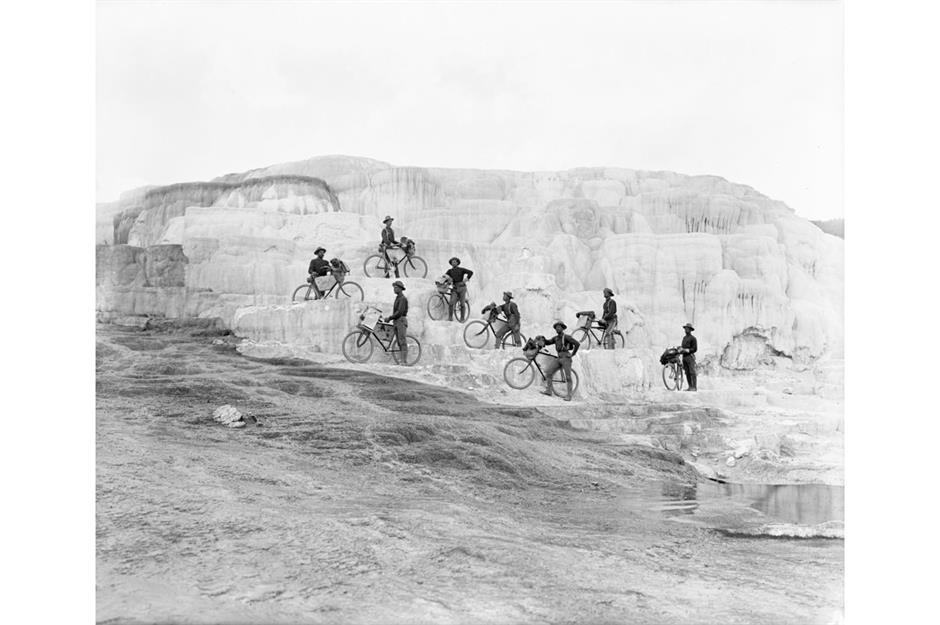
Following the Civil War, the US Congress reorganised the military, establishing four regiments of African-American soldiers, which included many of the 180,000 African-Americans who had served in the Union Army. Native American tribes who encountered these Black cavalry troops reportedly called them 'buffalo soldiers', a name that became synonymous with all African-American regiments until the military was desegregated following World War II.
The name is believed to reflect both the soldiers' resilience and their appearance. Here, a group of buffalo soldiers, who also served as rangers in national parks, pose with bicycles on Minerva Terrace in Yellowstone Park.
c.1897: Italian immigrants in New York
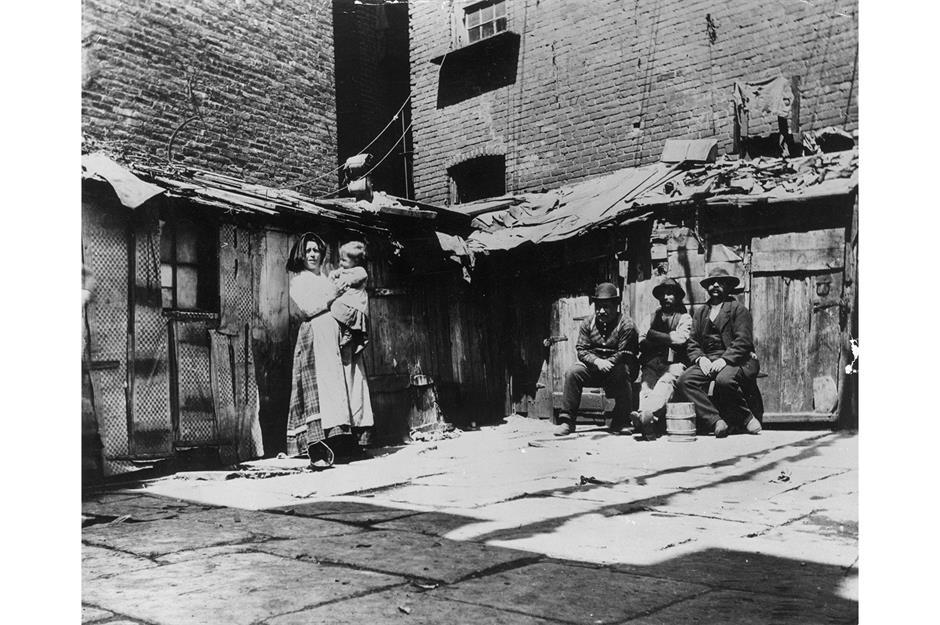
This image of a family of Italian immigrants living in a run-down shack on Jersey Street, in the area now known as SoHo, was taken by Jacob Riis, a Danish-born American reporter, social reformer and photographer. His 1890 book How the Other Half Lives shocked readers with its graphic depictions of the living conditions in New York’s slums.
Many Italian immigrants came from the poor rural south of Italy or the island of Sicily in search of steady work. In the 1890s they numbered 600,000. By 1920, this had leapt to four million – more than 10% of the nation’s foreign born population.
c.1898: Chinatown, San Francisco
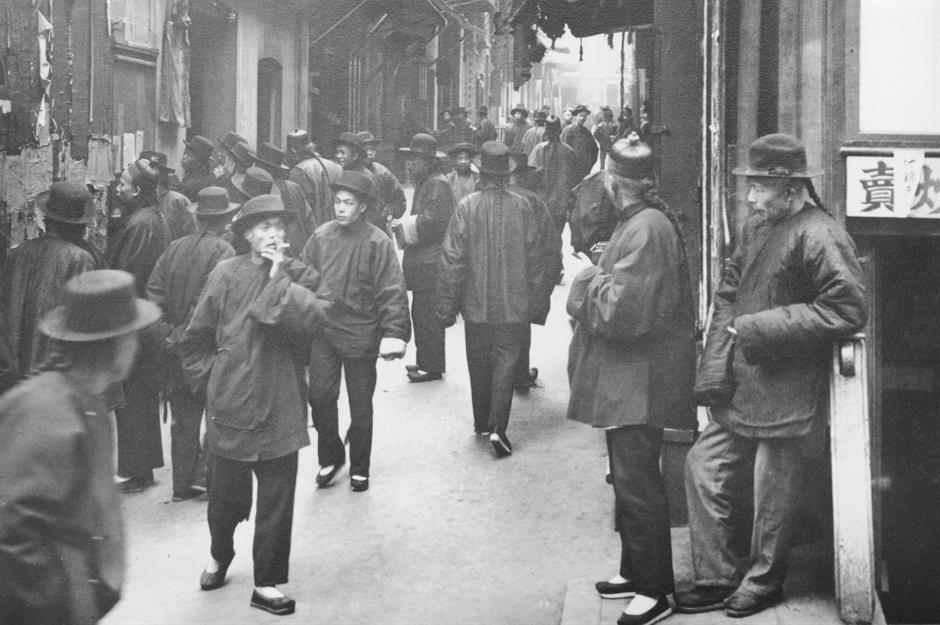
Established in the 1850s, San Francisco's Chinatown is the oldest in North America and is closely tied to the history of Chinese immigration to the United States. It grew rapidly after the California Gold Rush and the construction of the Transcontinental Railroad attracted large numbers of Chinese workers to the West Coast.
While Chinatown offered a cultural refuge for these immigrants, they still faced significant racial discrimination and repressive legislation. By the late-19th century, Chinatown was home to a sizeable population, despite the passing of the Chinese Exclusion Act in 1882, which suspended the immigration of Chinese labourers for a decade.
1900: Immigrants arriving at Ellis Island
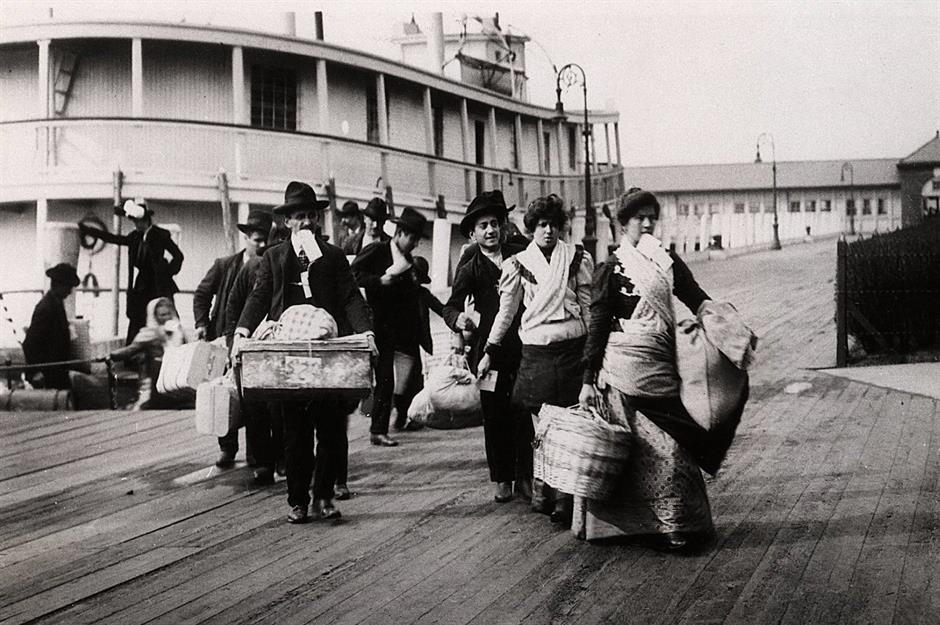
In the final year of the 19th century we see a group of immigrants striding hopefully onto Ellis Island. The immigration station there opened in 1892, serving as the first glimpse of the New World for some 12 million people until its closure in 1954.
Entry was by no means guaranteed, as many were turned back due to physical and mental illness or because of their political beliefs. Nevertheless, it is estimated that 40% of current US citizens can trace at least one ancestor back to those who arrived at Ellis Island under the watchful gaze of the nearby Statue of Liberty.
Now discover the biggest US history myths that many people believe
Comments
Do you want to comment on this article? You need to be signed in for this feature